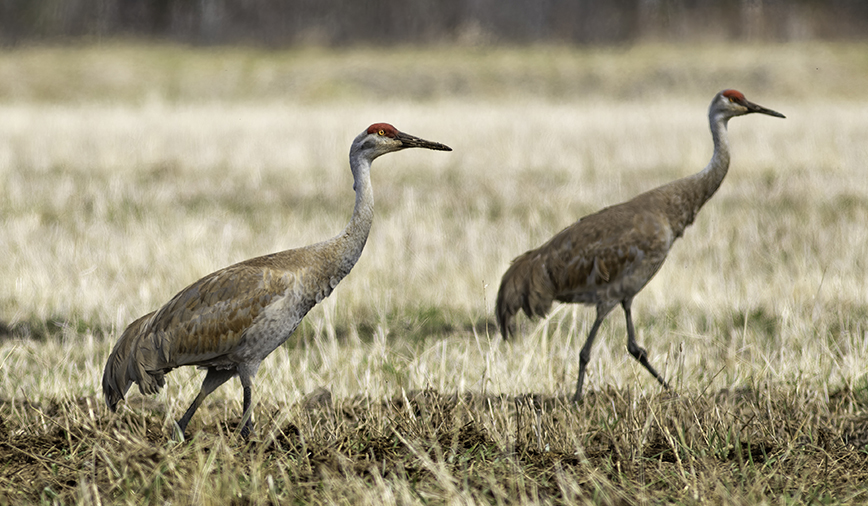September 7, 2012
Once upon a time Canada geese were just that—geese from Canada. Well, Canada and thereabouts. A denizen of the north, the birds’ appearances in our area were primarily during migration, and their flocks were a sight to behold.
I remember one fall, I want to say it was in the mid-1970s, when a particularly large group settled down on the lagoon at Northside Park, just up the street from my parents’ house in Wheaton. Word quickly got around that the geese were in town, and people drove out of their way to see the striking and majestic visitors before they continued their journey south.
But that was a long time ago. Today Canada geese are an all-too-common part of our local landscape, at least according to some people. Thanks to a wildly successful reintroduction program, Branta canadensis has become the sort of creature many folks go out of their way to avoid, instead of to see.
There is, however, a new bird in town. Well, actually it’s a very old bird, one whose skeletal structure, and presumably appearance, has remained unchanged for 10 million years: the sandhill crane.
Over the past year or so, we’ve gotten numerous emails and phone calls about this prehistoric, yet very modern, bird showing up in locations throughout Kane County. Some of the sightings are to be expected— cranes foraging in cornfields, for instance. But others are little more unusual—cranes on sidewalks. Cranes in front yards. And in a fun but slightly disconcerting twist on bird watching, a crane peeking in a window, eyeballing the humans who thought they were the ones doing the watching.
A bird whose numbers once plummeted, due to a double-whammy of overhunting and habitat loss, sandhill cranes are riding a wave of re-popularity. Natural area restoration efforts have brought wetlands, sandhills’ preferred breeding habitat, back to our landscape, and hunting bans have reduced pressure on their populations, allowing them to grow, and grow.
Recent research shows that the northeastern Illinois sandhill population is increasing at a rate of about 30 percent per year, as birds from burgeoning Wisconsin flocks spill over the border. And now, as Wisconsin considers adding a sandhill crane hunting season, I can’t help but wonder, will sandhill cranes be our next “Canada goose”—that is, a beautiful creature some folks love to hate?
Granted, the calls and emails we’ve received so far have been overwhelmingly positive. People generally are amazed to see such large birds—sandhills are about 4 ft. tall—and impressed by their coloration— gray with a dusting of rust across the back, capped off with a splash of red on the forehead on adults. Some callers also have marveled how at-ease the birds seem, even while foraging under harrowing conditions such as those that prevail along Randall Road in St. Charles.
But there have also been a couple of people who’ve been, shall we say, less than thrilled with a certain aspect of the sandhill crane. No, not the, er, poop, which seems to be the main complaint about Canada geese. The issue with cranes, it seems, is the noise.
Sandhill cranes are a gregarious bunch, and even a couple of birds can cause a bit of a ruckus. Their vocalizations range from soft contact calls to loud, rattling unison calls—sounds meant to reinforce bonds between pairs. Add in the warning calls of two parents defending their young, and you’ve got the potential for quite a racket—not surprising when you consider that the name crane is from the Anglo Saxon word cran, to cry out.
To birders, the sound of sandhill cranes calling can be music to the ears. But to someone trying to sleep, the noise can be unwelcome, to say the least.
Farmers also have their share of crane-induced headaches–not so much here in Illinois, yet, but in Wisconsin, where densities are higher. There, sandhills are considered a threat to corn crops. The birds, it seems, have a taste not only for the ripened grain in fall, but also for the tender young shoots in spring.
Wisconsin farmers who support a sandhill hunting season point out that, while only a few dozen pairs were known to exist there in the 1930s, current population estimates range from 15,000 to 25,000 individuals, with numbers increasing annually. The giant Canada goose subspecies, by comparison, was considered eliminated as a breeding species in Wisconsin in the 1930s; however, through extensive conservation efforts, its numbers grew to 11,000 in the mid-1980s and more than 120,000 today.
Now, sandhill cranes and Canada geese are distinctly different birds, with different diets and different breeding habits. But still, the question hangs out there, will sandhill cranes be our next “Canada goose”?
I’m guessing it’s too soon to say for sure. Wildlife biologists have learned a lot since giant Canada geese were reintroduced as a subspecies. But at the same time, the sandhill crane population’s double-digit percentage gains do sound eerily familiar.
What do you think? Are sandhills poised to become the next Big Thing, for better or worse? Honk if you think Yay! I mean Yes.
Pam Otto, a fan of cranes, is the manager of nature programs and interpretive services for the St. Charles Park District. She can be reached at 630-513-4346 or potto@stcparks.org.

